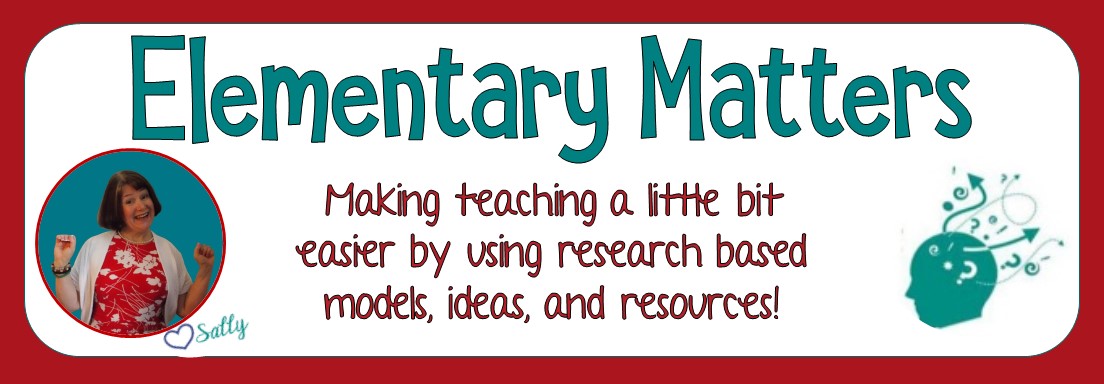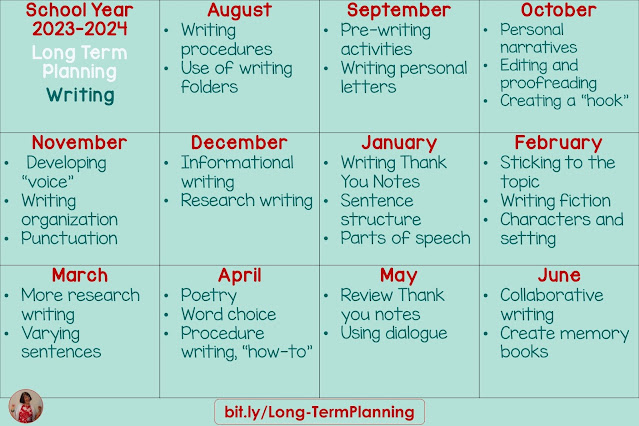I never thought of long-term planning as something set in stone. In fact, I would never think about writing long-term plans in permanent ink!
I'll never forget the time I got marked down on my teacher evaluation because I didn't "show evidence of long-term planning." It was pretty frustrating since, had she asked, I'd have directed her to the flap inside my plan book with all my charts!
Yes, I'm a planner, but I do know better than to expect everything in the classroom to go exactly as planned!
Here are 8 things to think about while you're long-term planning"
1. Break the year into manageable chunks.
I typically do short-term planning by the week, but my longer plans are split into months. I know a lot of teachers like to use online planners, but I like to use old-fashioned paper. I start with a big grid labeled with each month.
2. Start with the big picture.
Even though you've plotted out the parts, we all know things will change. But if you teach the same grade next year, a lot of the work will be already done!
3. Establish routines.
We all know that the first few weeks of the year are dedicated to establishing routines that will be in place for the rest of the school year. If these routines are well taught, they will make your life easier in the long run. One example is starting each math lesson with 5 minutes of fact fluency practice.
These are the systems I use. They are easy to differentate and keep organized, and the students love them. (Much like a video game, it's a great accomplishment to "move up a level!") The students can practice alone, with a partner, with a small group, or even on ipads or laptops. Once the routine is set, that frees up the teacher to prepare the classroom for the rest of the daily math lessons, or to "listen in" to assess.
I also start my reading groups with a warm up. These phrase cards are perfect for this purpose. (See more about reading warm ups HERE.)
Here are some other resources that can help you establish valuable routines:
Certain things are very appropriate for teaching at certain times of the year. For example, when I created the list of writing chunks above, I immediately put poetry into the April category, as April is poetry month. Clearly, teaching writing procedures comes at the beginning of the school year. (late August here) January is a great time to teach writing thank you notes, as they have a lot to write from the holidays! (Writing Thank You Notes) I teach writing friendly letters near the beginning of the year, because once they've learned the "routine," it goes straight into the Sub Tub! (See HERE for this routine!) I try to get most of the "nitty gritty" writing, (editing, proofreading, punctuation, and parts of speech) near the beginning, then go back to these as I see they need review.
When teaching about life cycles, I'll probably teach certain life cycles around December, like pine trees and reindeer. (See Winter LIfe Cycle Bundle) Some life cycles are more appropriate for springtime, like robins, butterflies, or dandelions. (See Spring Life Cycle Bundle)
5 Collaborate with colleagues.
We all have our strengths as well as weaknesses. We all have different experiences and different ideas. We all have our own styles. And thank goodness for this! As we chat with our colleagues and teammates, we can use these differences to benefit our students. Which teacher on your team is best at organization? Which teacher on your team is best at modeling writing behaviors? Which teacher on your team is best at finding the right books that model the skills you're working on? Most of the teaching for your own students goes with you, but it doesn't hurt to branch out, does it?
6. Integrate subjects when you can.
We all know there is never enough time in the classroom to do all that is needed to be done, as teachers all wear plenty of hats! When you are able, do "double duty!" What does that mean? Well, you can teach reading and writing skills while teaching social studies as well! You can teach science while integrating important math skills such as graphing and measuring! The resources below are perfect for combining subjects to save class time.
- Daily Writing Prompts and Morning Greeting Questions for the Whole Year
- Science and Social Studies Activities for the Year
- Fun and Engaging Digital Science Topics Practice and Review Boom Cards
- Fun and Engaging Digital Social Studies Topics Practice and Review Boom Cards
- Weather and Climate Bundle: Reading Comprehension for Active Learners
- Reading Comprehension for Active Learners Science and Social Studies: The Bundle
7. Don't forget sub plans!
It's a good idea to put aside plenty of activities that are valuable tasks that can be done any time of year, need minimal directions, and aren't dependent on previous lessons. This is a great time for review!
As mentioned above, I have my friendly letters all set to go in my sub tub. It's an activity that can be done over and over again, and their writing skills will grow each time. (Plus, they love it!)
These "no-prep" activities are perfect for such occasions! I keep several pages of my Camping No-Prep in the sub tub, as these can be done any time of year. But if you know you're going to be out, try one of these seasonal sets. (They do love when you integrate something seasonal with learning, don't they?) Seasonal No Prep Activities, Worksheets, and Printables for the Whole Year.
8. Be flexible.
Here's a hint: when you see something you think will help you plan for a whole year, put it in your wishlist! Then, when a sale comes up, you can easily move it to your cart at the discounted price!
Happy teaching! May this one be the one filled with joy, excitement, wonder, and endless possibilities!

























